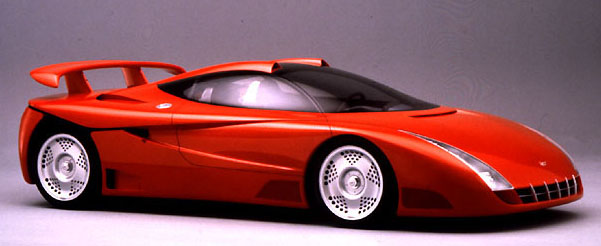1998 Ferrari F100
- Story Cars

- Oct 19, 2021
- 2 min read
From Fioravanti comes a Gran Turismo concept for the year 2000, dedicated to the Prancing Horse: the F100 salutes the centenary of Enzo Ferrari's birth. A compact, high-performance engine - such as a V 10 - for a vehicle with outer measurements makes it smaller, lighter, and easier to drive than the huge supercars we have become accustomed to seeing in recent years. A semi-automatic gearbox and the F1-type paddle selector mounted behind the steering wheel were natural choices here. The aim is to provide relaxed driving conditions, permitting concentration to focus on the unique pleasures of fast driving.
The spontaneous hallmark of history: the outer skin bears one of the classic design themes associated with the Prancing Horse cars - the famous Ferrari "wave," that plastic, almost sculpted shape. Seen here as a claw mark, it starts at the nose, spreading and developing three-dimensionally around the whole of the car's perimeter.
The search for lightness moved in two directions: structure and components. The engine air intakes, for example, have been lodged in the upper part of the roof panel, a location that takes advantage of the boxed roof structure as well as improving rear vision. As far as components are concerned, the front and rear neon light clusters, for example, are styled with the classic Ferrari designs in mind but are built to a unique, lighter specification. The wheels were the subject of a special design project too. The Fergat company, the European leader in steel wheel design and production, worked with Fioravanti to match innovative design with cutting-edge technology.
New steels and high resistance levels - with load limits of over 600 MPA -sophisticated design using computer-generated simulations, further deformity, and assembly techniques have all made it possible to conceive and engineer steel wheels of quite stunning beauty at a significantly reduced weight. In addition, the forging requirements themselves lead engineers to a naturally more aerodynamic wheel. Cabin design hinges on a philosophy of relaxed driving, achieved here in particular by choice of the Ferrari F1 gear-selector and the two-pedal action -magical, gradual, equilibrium. The design of the dash develops from the two selector paddles behind the wheel, and almost all the controls are located on the wheel itself.
The support provided by the lower part of the seats maintains a relaxed muscle position all along the legs. In the case of the driver, practically guides the feet onto the accelerator and brake pedals, almost like an F1 car. The speed of this kind of F1 gear-selector means the driver must view and collate cockpit information faster and more immediately, and so traditional-type instrumentation is no longer suitable. It is replaced here by an innovative type of digital-analog instrumentation with simple but highly effective graphics.
Source: www.fioravanti.it














































Comentarios